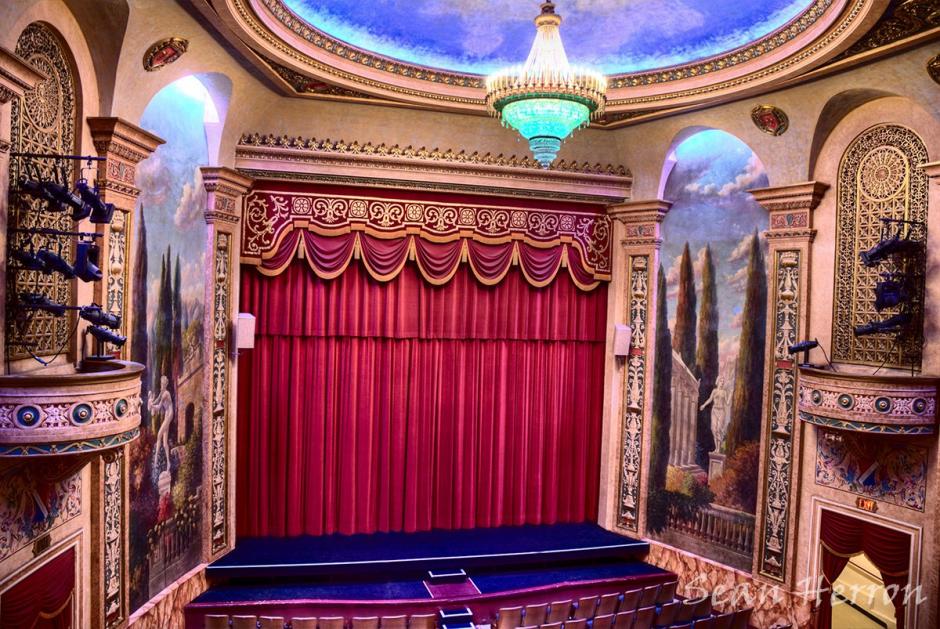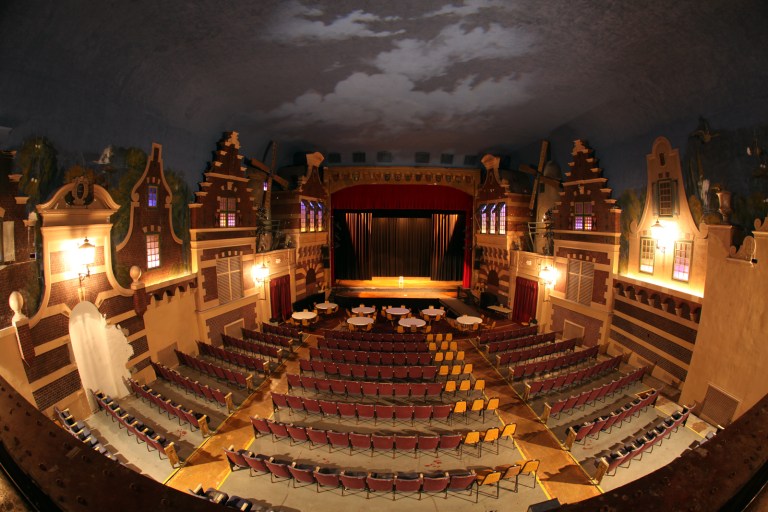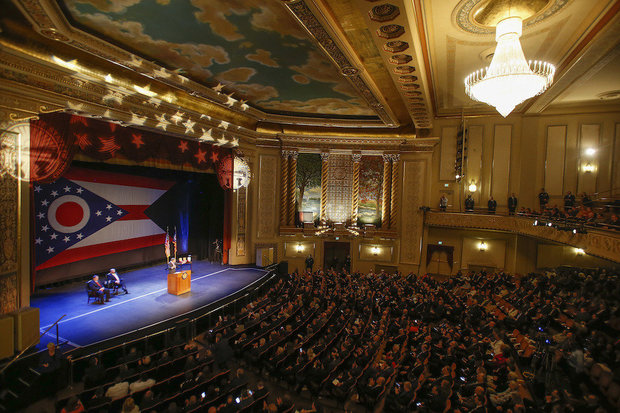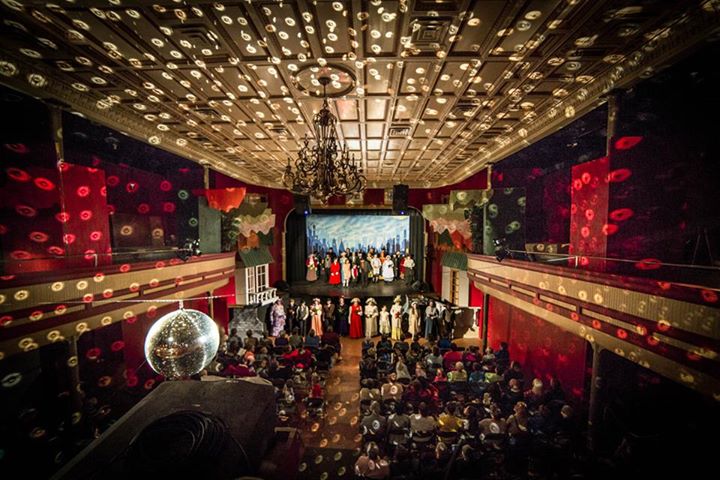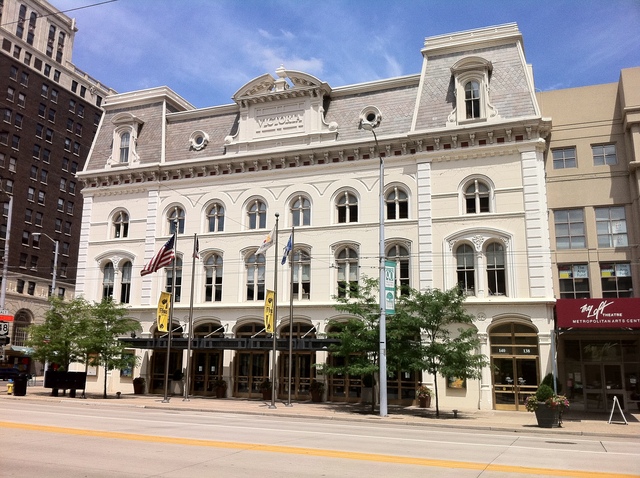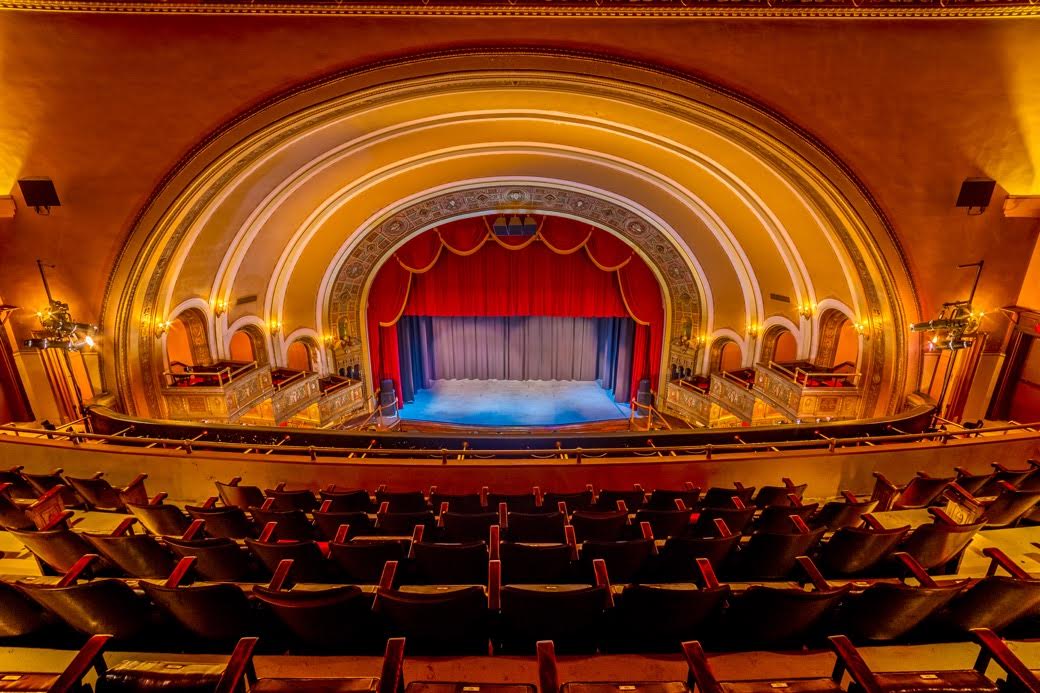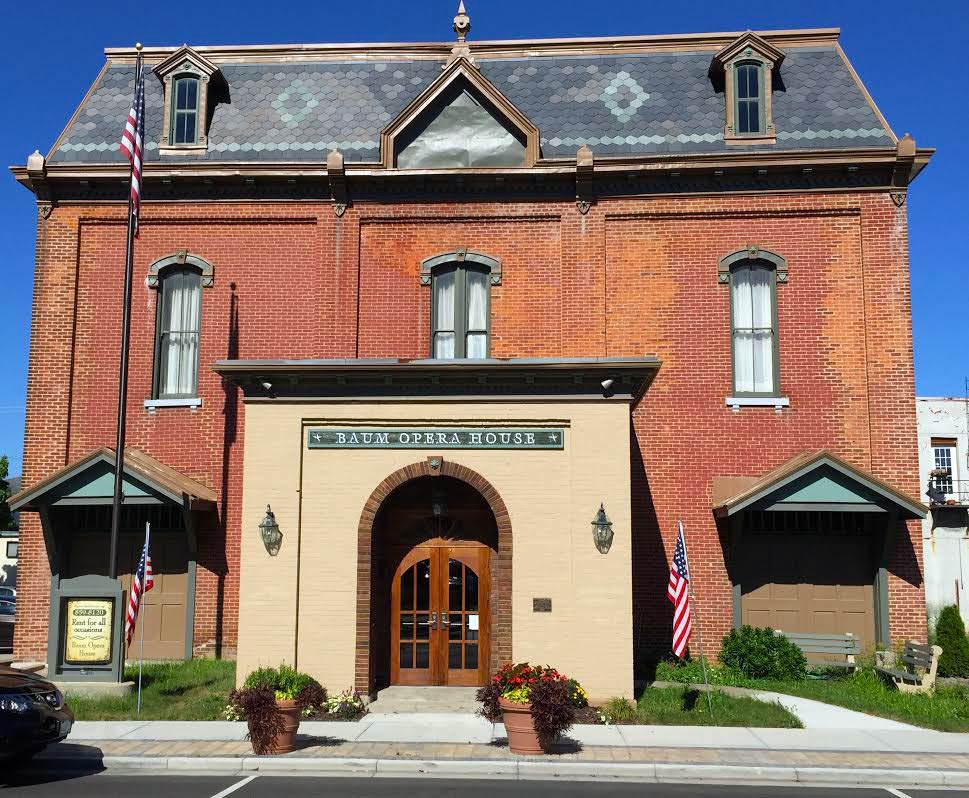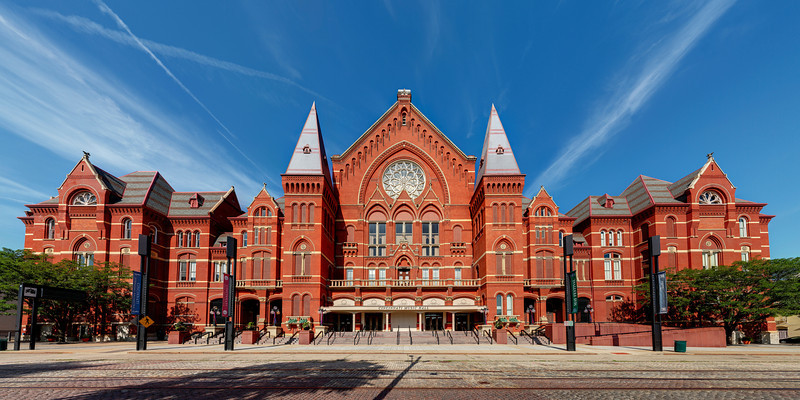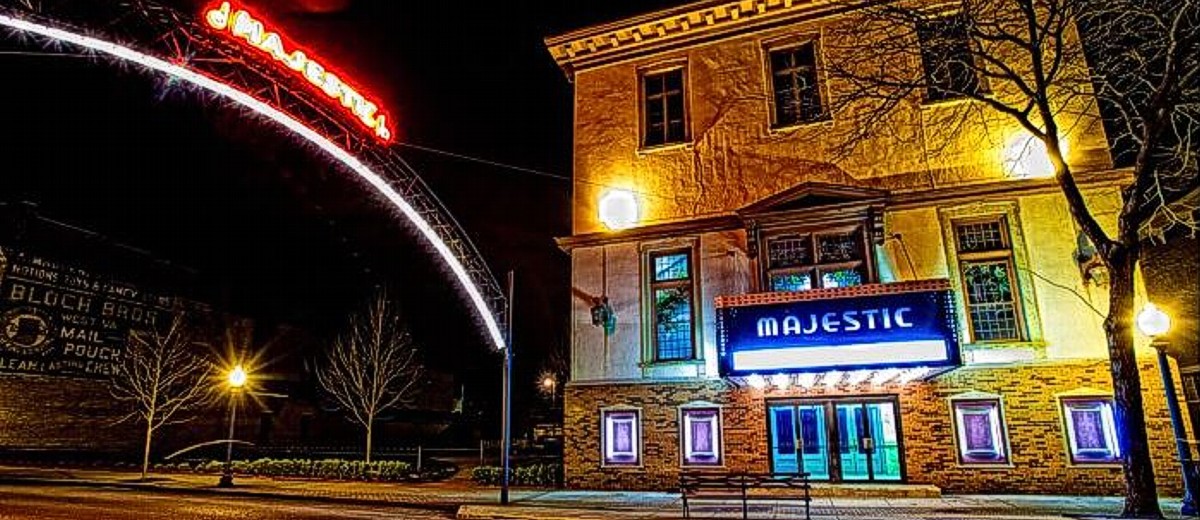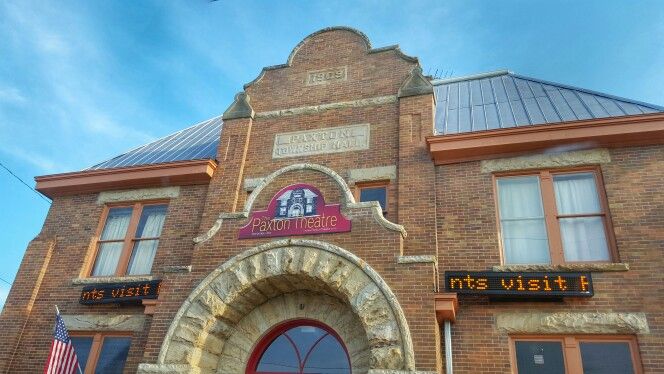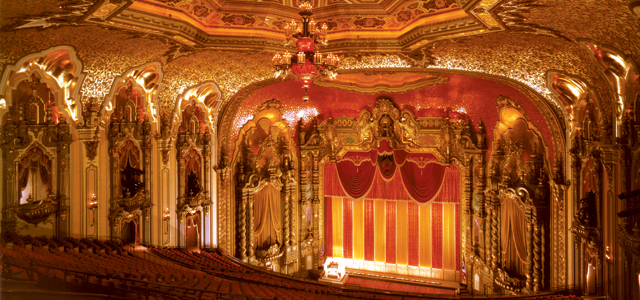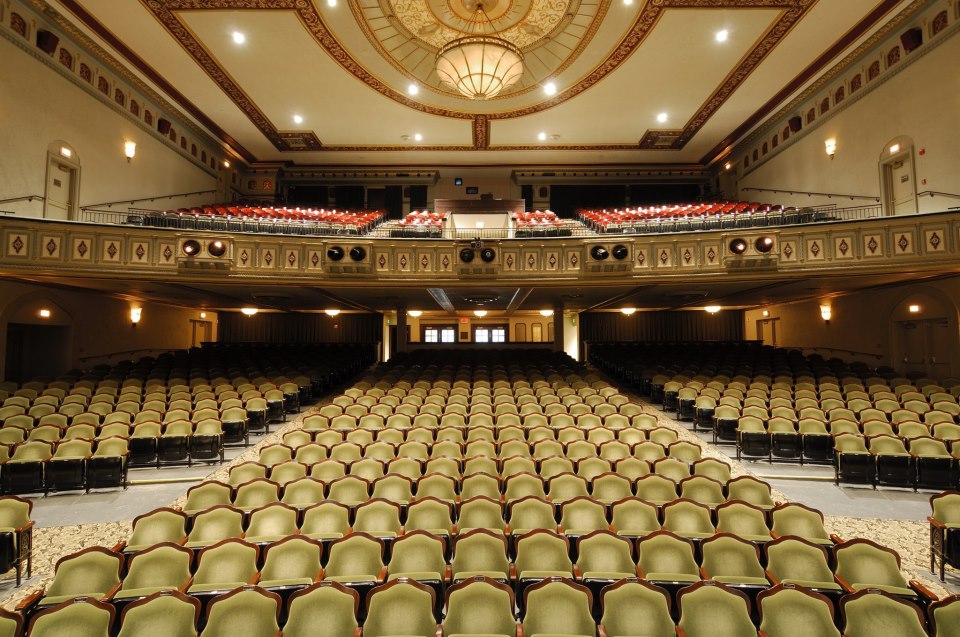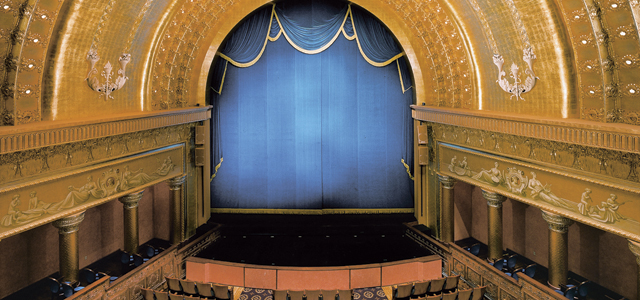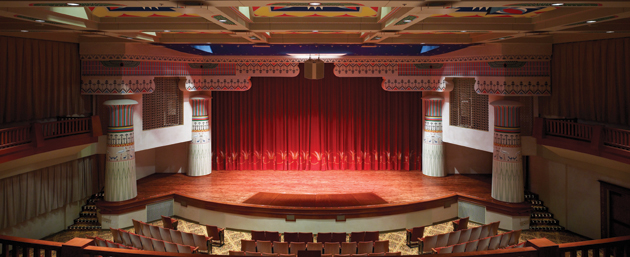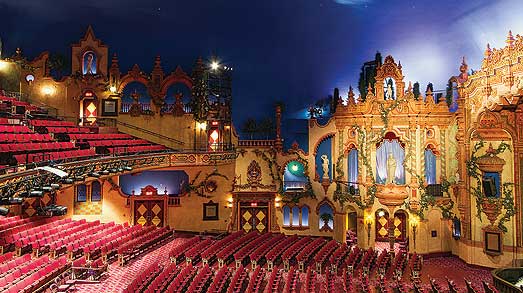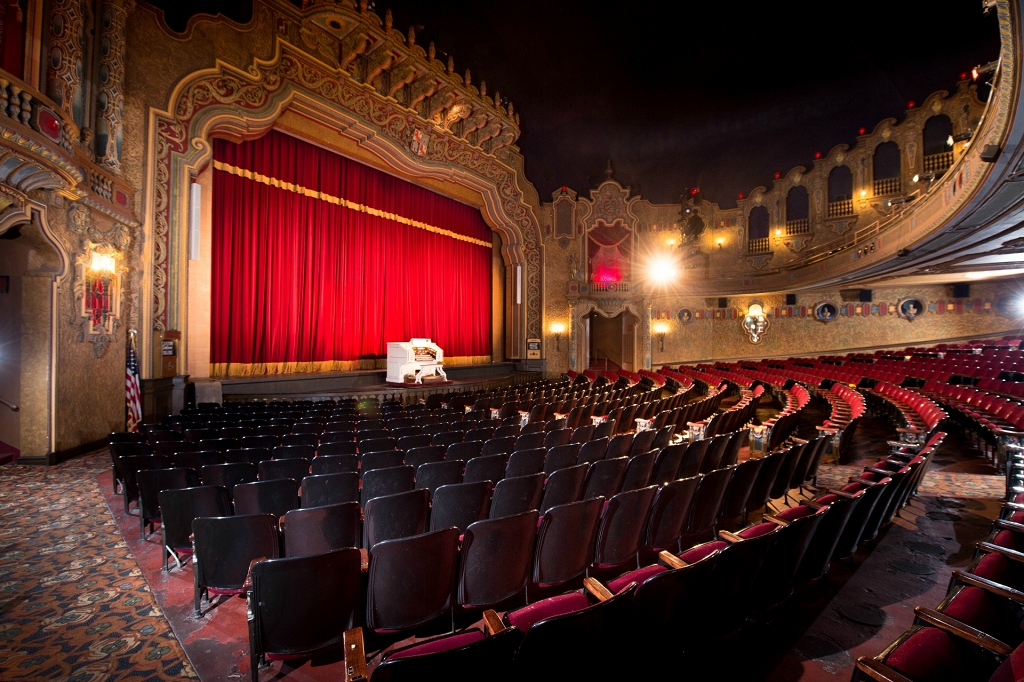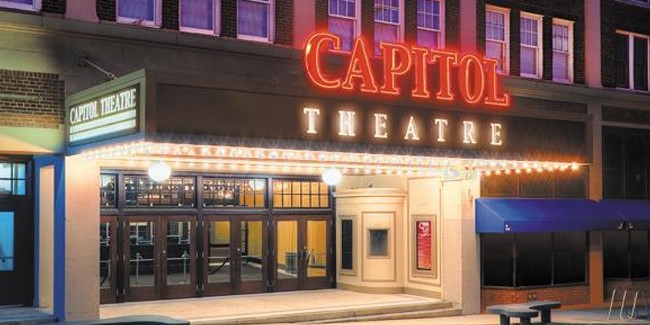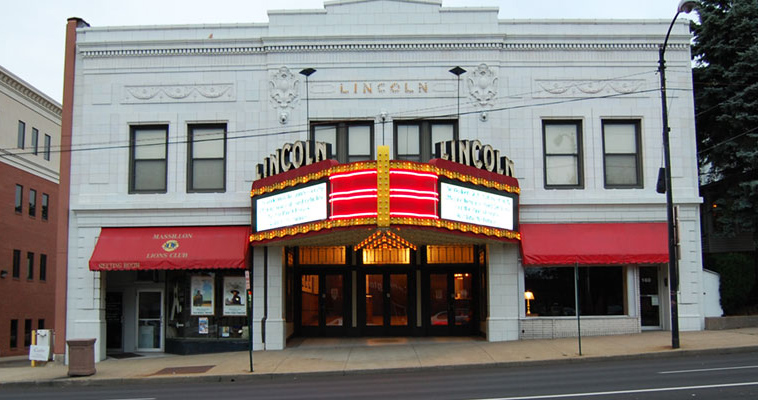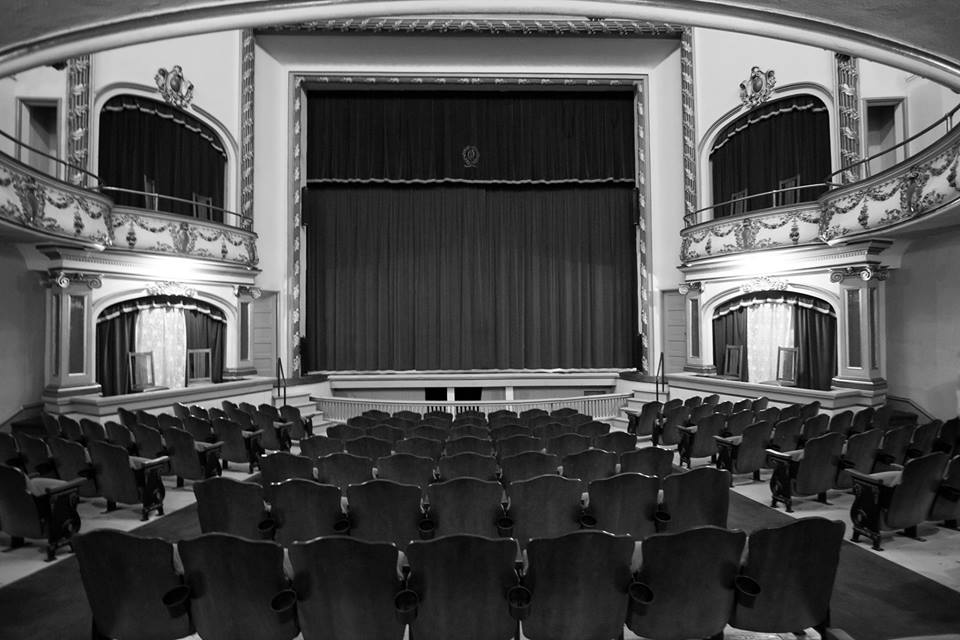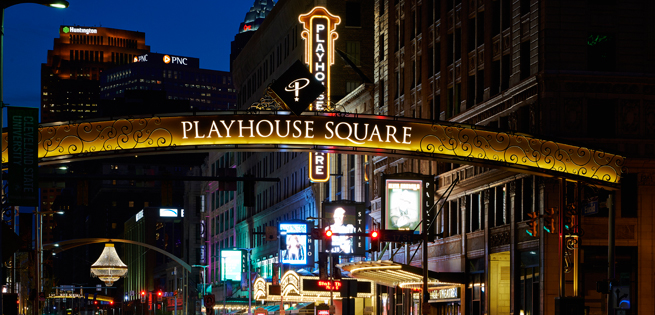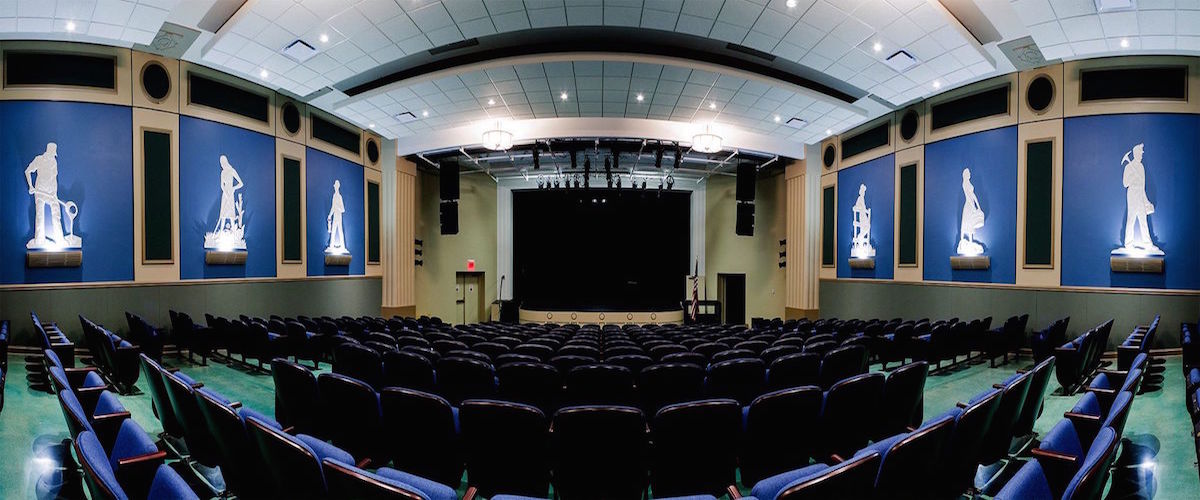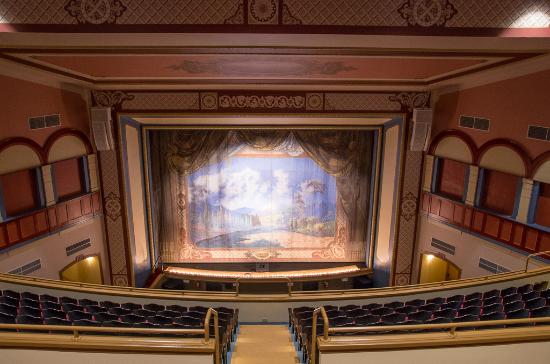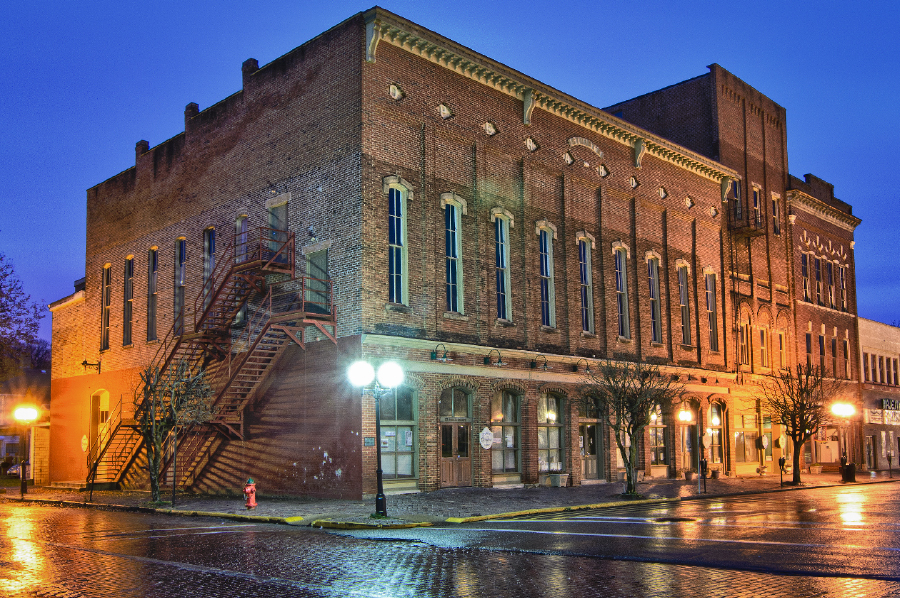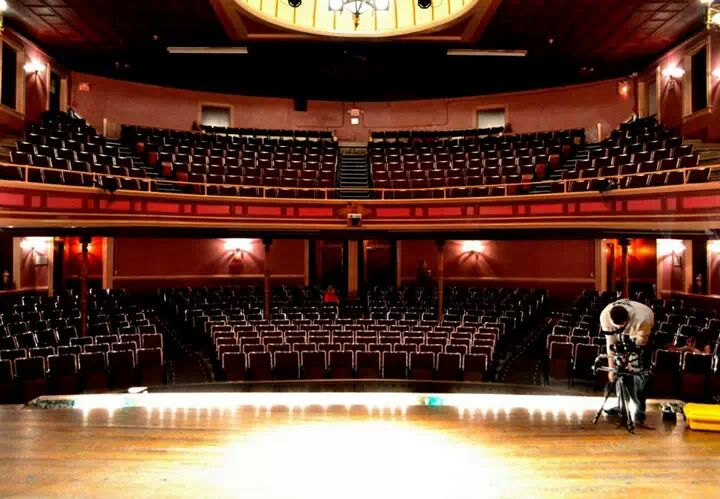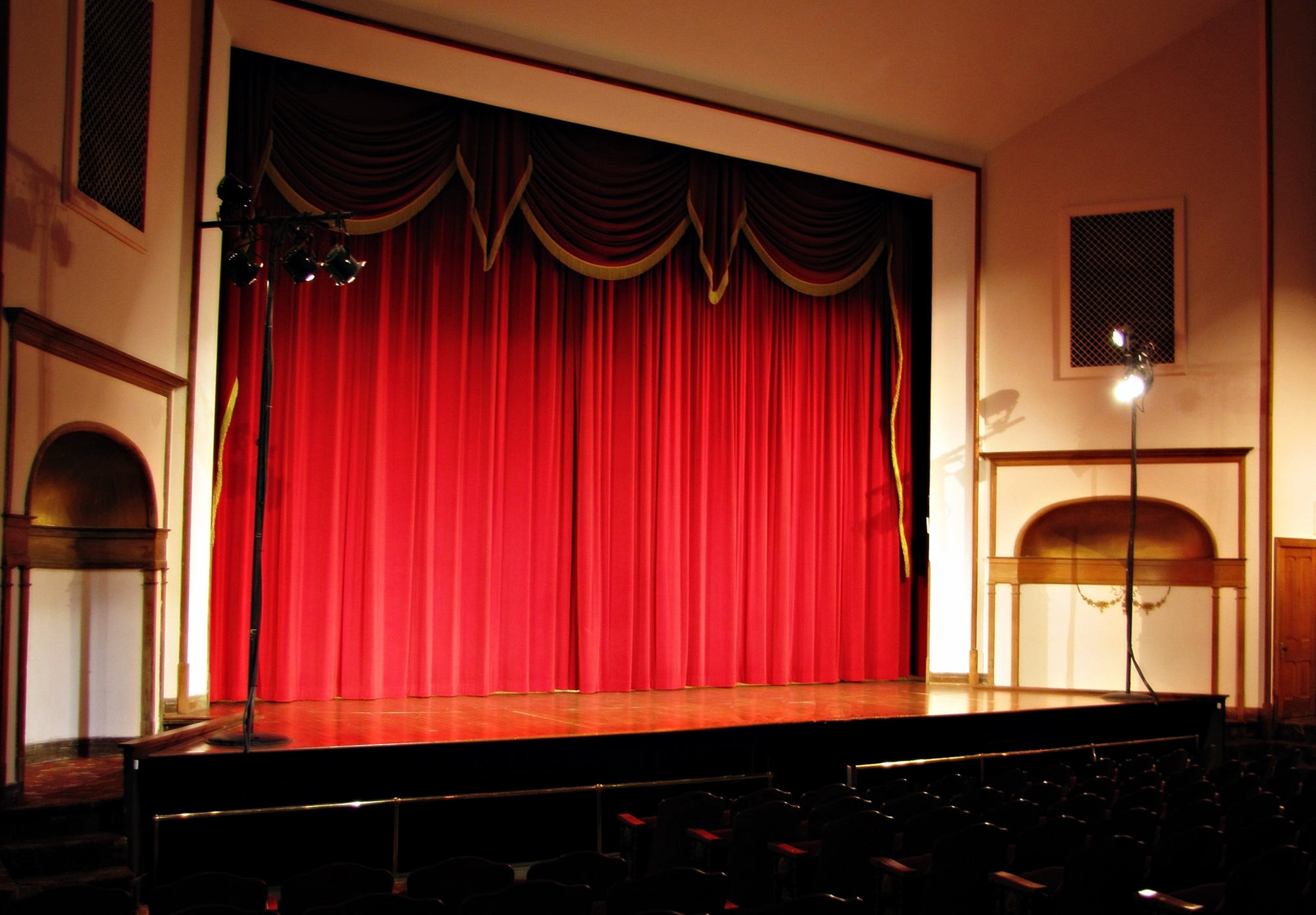Webinar: Ohio’s Historic Opera Houses & Theatres
Thursday, May 5th – 2:00 pm – 3:00 pm
Heritage Ohio is excited to partner with the Ohio Arts Council for an in-depth look at Ohio’s historic theatres and opera houses. We’ll begin with the cultural history and development of these storied institutions, then transition to stories of several rural opera houses and theatres making significant economic and cultural impact in their communities, and conclude with four case studies of successful restoration and preservation efforts from around the state.
Featured Theatres & Opera Houses
Twin City Opera House – McConnelsville
The Twin City Opera House has been in continuous operation since it opened as an opera house and town hall in 1892. Today, 130 years later, the opera house continues host a variety of live performances, movies, and community events.
Ashland Schine’s Theatre – Ashland
The theatre first opened its doors as a deco-style movie theater in 1942. Over the years, the building entered a period of decline, eventually closing its doors in 2009. In 2015, a dedicated group of volunteers known as the Ashland Schine’s Theatre Organization purchased the theatre and began to restore it with the goal of making Ashland “Schine” in 2022.
Murphy Theatre – Wilmington
This historic grand theatre was built in 1918 as a gift to the people of Wilmington. More than 100 years later, it has become an economic boost to the community and the center of activities in Clinton County, with a wide variety of programming attracting audiences from miles away to shop, eat, and enjoy downtown Wilmington before and after shows.
St Marys Theatre and Grand Opera House – St. Marys
Built in 1895 as a performance theater and later modified as a movie house in 1930s and 1940s, the historic theatre is now under rehabilitation. Friends of the St. Marys Theatre and Opera House, Inc., is transforming the space into a vibrant performing arts center featuring artistic and educational performances for generations to come and is expected to reopen in September 2023.
The Most Stunning Historic Theatres in Ohio
We love seeing historic theatres restored in Ohio to their former glory and once again a proud centerpiece of the community. Can you believe some of these theatres were once threatened with demolition to make way for parking lots? Thanks to the work of preservationists across the state, you can still visit these stunning Ohio historic theatres.
Northwest
The Ritz Theatre – Tiffin
The Ritz Theatre opened to great fanfare in December of 1928 in downtown Tiffin. The theatre’s design takes elements from the Italian Renaissance, including an artistic interpretation of a Roman villa in the concert hall. The theatre was renovated in 1998, bringing the theatre back to its original charm and elegance.
Today, the theatre offers a variety of performances including live music, classic films, and theatrical pieces. See the current schedule here.
The Holland Theatre – Bellefontaine
The Holland Theatre is one of the more uniquely designed theatres in Ohio. Both inside and out, the theatre transport the visitor to Holland, with classic Flemish design, including a dutch village-scape in the interior. The theatre opened in 1931 as The Schine’s Holland Theatre. While some alterations have occurred over the years, much of the original splendor of the theatre is intact and ready to wow.
With numerous performance throughout the year, you will have plenty of opportunities to visit the theatre. See the current schedule here.
The Sandusky State Theatre – Sandusky
The Sandusky State Theatre opened in 1938 as The Schine Theatre with a showing of Night Watch. The theatre fell into disrepair in the 1960s, but was extensively renovated in 1990. Theatre hosted a performance of Michael Bolton to celebrate its 75th anniversary. For its centennial anniversary, the Sandusky State Theatre hopes to be completely renovated to its original splendor.
The Sandusky State Theatre offers a wide variety of programming. See their upcoming events here.
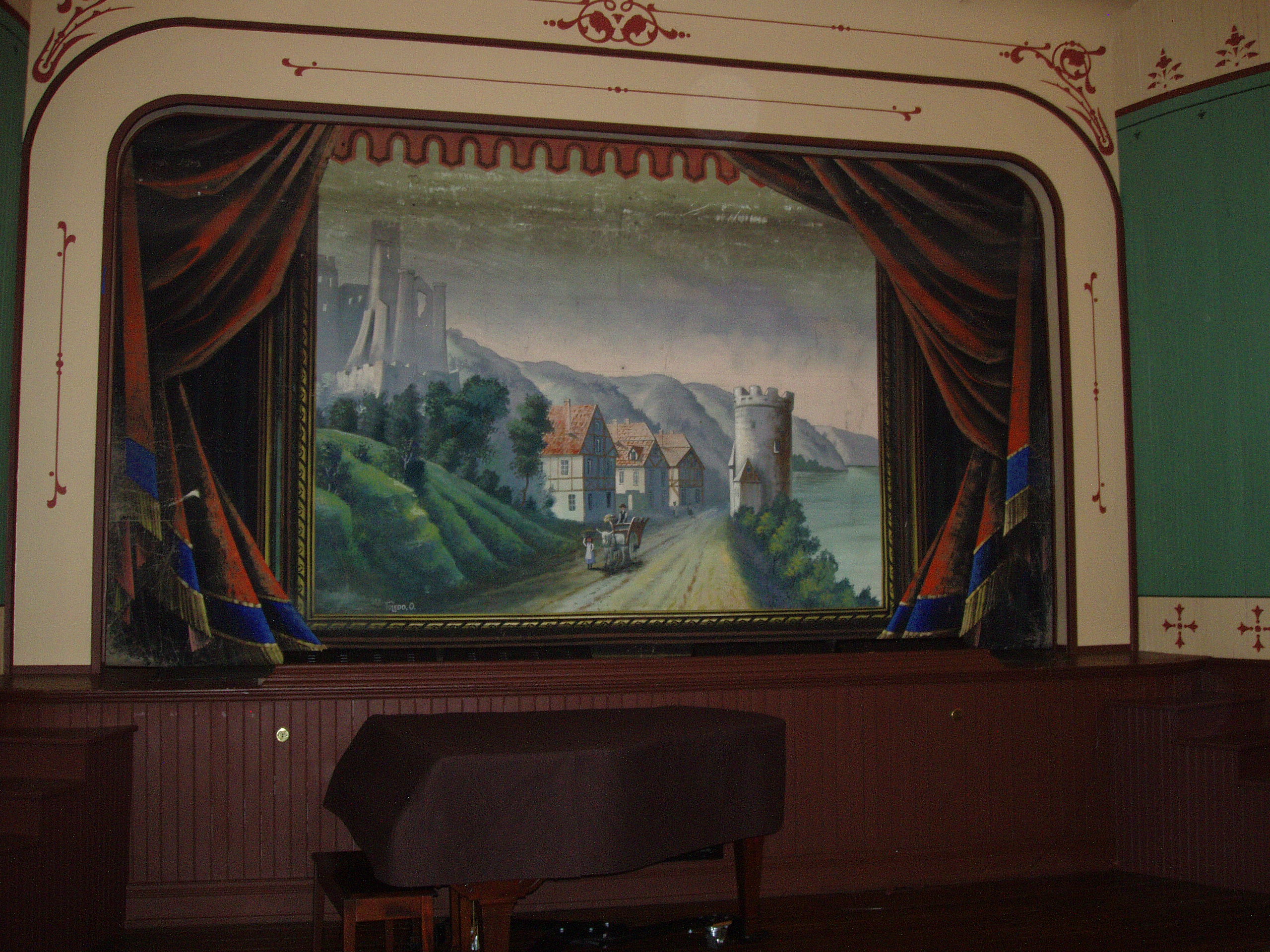
The Pemberville Opera House – Pemberville
Resting on the second floor of the Pemberville Town Hall, the Pemberville Opera House opened to Jeptha’s Daughter, an adaptation of the Biblical story. The opera house was wildly popular in before WWII, especially after electric lights were added in 1899. Following years of neglect, renovations were started in 1998 to return the opera house to use.
Today, the Pemberville Opera House hosts several productions every year. See their current schedule at the link above.
The Huber Opera House & Event Center – Hicksville
The Huber Opera House started life as Mackey’s Brick Hotel in downtown Hicksville in 1882. After a fire destroyed the Pettit Opera House, the hotel was converted to an opera house in 1895. The opera house remained the center of community life well into the 1970s, before it became rundown. In 1999, a coalition of community members and businesses purchased the opera house, giving it a new lease on life.
You have plenty of opportunities to visit The Huber Opera House. See their current schedule here.
Southwest
The Victoria Theatre – Dayton
The Victoria Theatre in Dayton traces its roots to The Turner Opera House, opened in 1866. The Turner only existed a few years before being destroyed in a fire. After the opera house was rebuilt, it underwent a series of name changes: The Music Hall in 1871, The Grand Opera House in 1885, The Victoria Opera House in 1899, and The Victoria Theatre in 1902. After surviving the Flood of 1913, another fire destroyed the building in 1918. After being rebuilt, it became The Victory Theatre. It thrived up into the late 1950s, but was marked for demolition in 1972. The community stepped up to save the theatre and the Victory Theatre Association began renovations in 1976. The theatre was transferred to the Arts Center Association in 1988 and was renamed again, back to The Victoria Theatre.
The Victoria Theatre offers extensive programming throughout the year. You can see their current schedule here.
The Murphy Theatre – Wilmington
The Murphy Theatre opened in downtown Wilmington in 1918. After operating as a Vaudeville theater, it was leased to Chakeres Theaters in 1929. In 1989, the theatre was purchased by a local group of citizens who sold stock options to save the theatre. Since the great work of these enterprising citizens, the Murphy Theatre continues to operate to this day.
The Murphy Theatre has numerous films and presentations every month. See their current schedule here.
The Baum Opera House – Miamisburg
The Star City Opera House was constructed by German immigrant Charles Baum in 1884, and quickly became the epicenter of life in Miamisburg. Like many other theaters and opera houses after WWII, it went through a series of name changes and uses, including housing a dinner theater, bowling alley, skating rink, and a few bars. It was slated for demolition in the early 1990s, but was purchased at a Sheriff’s sale. Since then, the Baum Opera House Association has managed the opera house and has fully renovated and restored the space to its former glory.
The Baum Opera House hosts several plays, musicals, and dances throughout the year. See their current schedule here.
The Cincinnati Music Hall – Cincinnati
Music Hall opened with a performance of Christoph Willibald Gluck’s Alceste in 1878. More commonly known as Cincinnati Music Hall, the concert hall is the defining structure of Washington Park in Cincinnati. With the decline of the Over-The-Rhine neighborhood, Music Hall’s future came into doubt. It was listed on the 2006 National Trust for Historic Preservation‘s 11 Most Endangered List. Through a grant from the City of Cincinnati, The Ohio Historic Preservation Tax Credit Program, and the generous donations of thousands of people, Music Hall has recently been renovated and will continue to serenade Cincinnati.
To see the current schedule of events at Music Hall, click here.
The Majestic Theatre – Chillicothe
The building that currently houses The Majestic Theatre was built in 1853 as a Masonic Hall. In 1876, the Masons designed an opera house to be built within the Masonic Hall. This opera house became the foundation for The Majestic. In 1904, the Masonic Hall and Opera House were sold, and sold again in 1915. The new owners changed the name of the theater to The Majestic Theatre and it soon became a cinema. After a sale of the building in the 1970s, the structure was renovated, and in 1990, the current non-profit association took control of the theatre.
Today, the theatre still shows films, as well as live performances. You can see the theatre’s full schedule of events here.
Paxton Theatre – Bainbridge
The Paxton Theatre is located on the upper floor of the Paxton Township Hall, opening around 1910. Soon after opening, the space was leased to show motion pictures, continuing under different operators until the early 1950s. In later years it was used as rental and entertainment space. In 1992, it was sold to host the Paint Valley Jamboree, which still takes place in the theatre. The building was recently sold and the current owners plan to make it the center of the community for years to come.
The Paxton Theatre continues to host the Paint Valley Jamboree, as well as numerous other musical guests and Shrek Jr. See all of the Paxton’s events here.
Central
The Ohio Theatre – Columbus
The Spanish Baroque-style Ohio Theatre opened as a Loew’s movie house in 1928. Opening at the end of the silent era of film, the theatre boasted its own orchestra and theater organ. The Ohio remained a cinema until the early 1960s and was threated with demolition by the end of the decade. The citizen-led “Save the Ohio’ campaign raised over $2M in less than a year and the Columbus Association for Performing Arts (CAPA) purchased the theatre. Today, the Ohio Theatre is the crown jewel of Columbus theatres, and hosts The Columbus Symphony Orchestra, BalletMet, The Broadway Series, and more than 100 CAPA events each year.
See CAPAs current schedule here.
The Midland Theatre – Newark
Opened in 1928, The Midland Theatre began its life showing Vaudeville shows and silent films. Interestingly, it was only a week later that the theatre premiered its first “talkie”. The theatre quickly transitioned into a full-time cimema, rotating films on a 3-day schedule. After years of decline, the theatre closed after the Blizzard of ’78 killed the boiler in the theatre. In 1992, The Longaberger Company purchased the theatre and renovated it. It entrusted the theatre to The Newark Midland Theatre Association to be stewards to the theatre and to provide quality programming for Newark.
Today, The Midland Theatre shows a variety of performances including live music and musicals. To see the Midland’s schedule, click here.
The Southern Theatre – Columbus
Just a few blocks south of The Ohio Theatre is another fantastic theater in downtown Columbus. Opened in 1896, the Great Southern Fireproof Hotel and Opera House filled a large gap in theaters in downtown. In the years prior to construction, 5 theaters were lost to fires in just 4 years. Other than being “fireproof”, meaning it was constructed with “fireproof” tile, brick, iron, steel, and concrete, the theatre was one of the first commercial buildings in Columbus to use electric lighting. In 1931, the theatre was converted to a cinema. After years of struggling, the theatre was closed in 1979. In 1982, the Great Southern Hotel was purchased and the owners offered the theatre to CAPA. After a combined effort of state and city funding, as well as donations from numerous donors and businesses, the Southern Theatre reopened in 1998.
See CAPAs current schedule here.
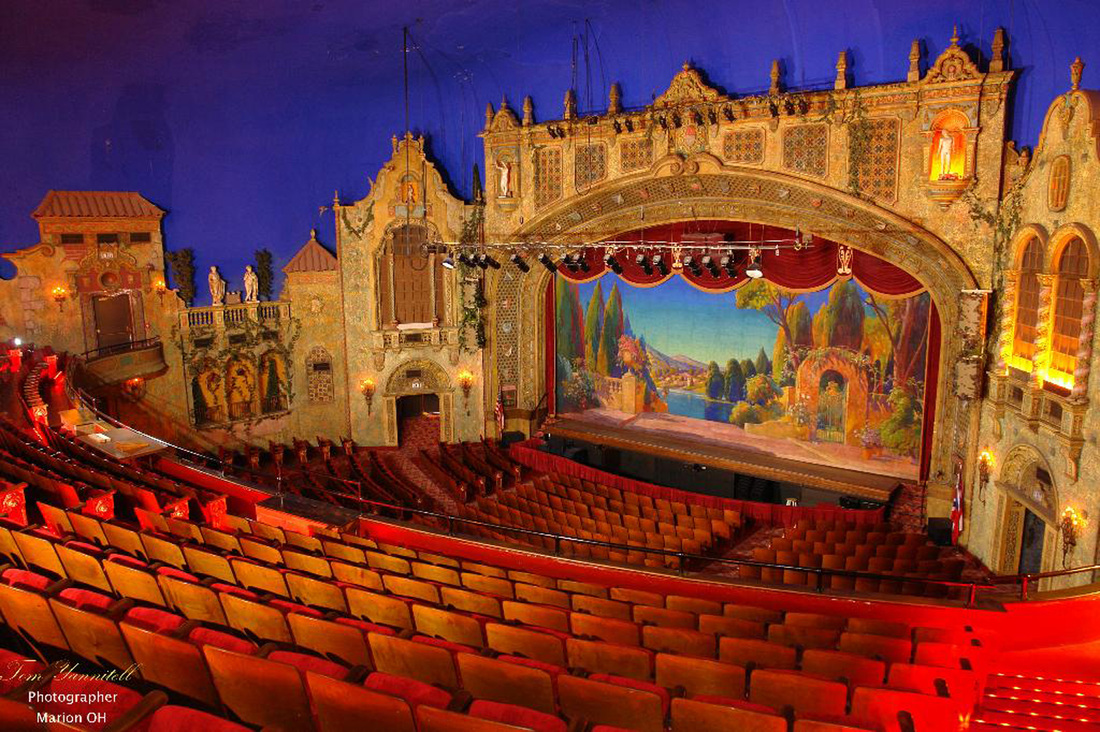
The Marion Palace Theatre – Marion
The Marion Palace opened as a cinema and Vaudeville theater in 1928, premiering with 4 Vaudeville acts and the film, Excess Baggage. The theatre is designed in Spanish Colonial Revival-style, and has several Roman and Greek statues designed by Pietro Caproni. Following several successful years as a cinema and multiple owners, the theatre needed extensive work to maintain its splendor. In the mid-1970s, a group of business owners, dubbed The Palace Guard, started a funding campaign to revitalize the theatre. The Palace Cultural Arts Association has operated the Marion Palace Theatre since then, and continues to provide new and exciting performances for Marion.
The Marion Palace Theatre shows films and live performances several times a month. See their schedule here.
The Lincoln Theatre – Columbus
Located just to the east of downtown Columbus, in the historic African-American neighborhood of King-Lincoln Bronzeville, is The Lincoln Theatre. Opened in 1928 as The Ogden Theatre, the Egyptian Revival theatre originally was used for Vaudeville performances and musical acts, but quickly transitioned into a cinema. It was renamed The Lincoln Theatre in 1939. Following several hard years, the theatre was closed in the early 1970s. The theatre reopened in 2009, with funding assistance from The City of Columbus and Federal Historic Preservation Tax Credits, and was widely seen as a catalytic revitalization project for the neighborhood.
See CAPAs current schedule here.
Northeast
The Akron Civic Theatre – Akron
In 1919, construction of a new theatre began in downtown Akron called The Hippodrome. In addition to a theatre, there were 30 planned shops inside an arcade. The project went bankrupt before it was complete. Soon after, Marcus Loew purchased the partially constructed Hippodrome and completed the newest Loew’s Theatre in Akron, designed by architect John Eberson. The interior is designed to resemble a Moorish castle, with Mediterranean elements throughout and is only one of a handful of surviving atmospheric theaters. After several ownership changes and nearly becoming a parking lot in the 1960s, the Akron Civic Theatre was extensively renovated in 2001, it reopened to fanfare with a new partnership with The University of Akron.
The Akron Civic Theatre has many live performances each month. See their current schedule here.
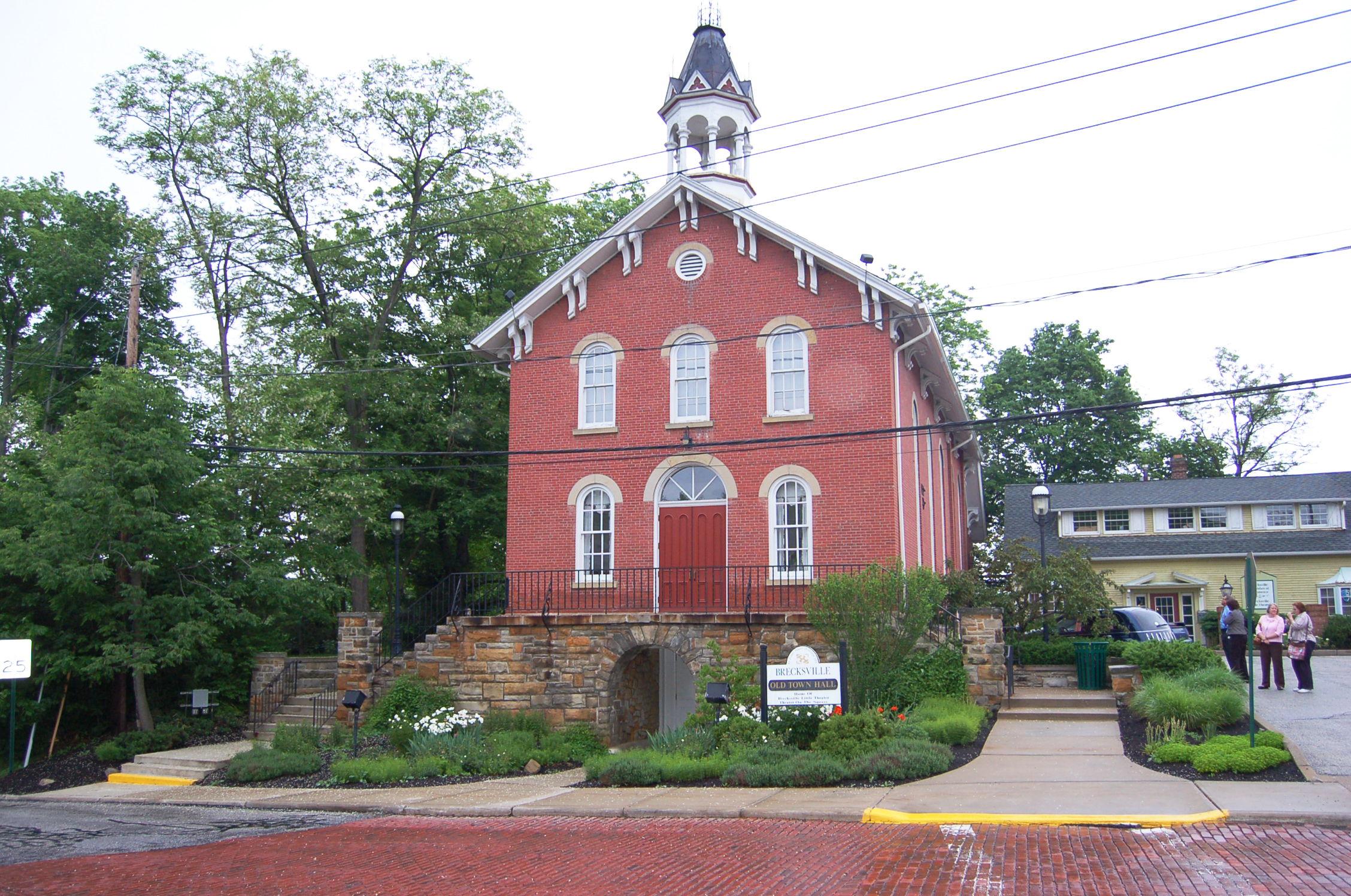
The Brecksville Theatre – Brecksville
The Old Brecksville Town Hall was built in 1874. In the 1940s, performances by the Brecksville Little Theatre began to be held in the town hall building. Paul Newman, yes, that Paul Newman, directed the comedy, Here Today in 1951 there. In 1975, a second theater group, Theater on the Square was established. Tragically, the old town hall was damaged in a fire in 1976, but was repaired. In 2017, it was announced the two theater groups were merging into The Brecksville Theatre and will continue to perform in the old town hall.
The new Brecksville Theatre has several shows lined up this fall. See the schedule here.
The Canton Palace Theatre – Canton
Like The Marion Palace Theatre and The Akron Civic Theatre, The Canton Palace Theatre was designed in a Spanish Colonial Revival style. It is also one of a few surviving atmospheric theatres. The Canton Palace Theatre opened in 1926 as a movie house and Vaudeville theatre. After a period of decline, the theatre closed on its 50th anniversary in 1976 and was soon scheduled for demolition. The Canton Jaycees saved the building and held it in trust until The Canton Palace Theatre Association was formed to operate the theatre. It reopened in 1980 and over $4M in renovations have taken place.
The Canton Palace Theatre continues to show films and have live performances. Their schedule of events can be viewed here.
The Gordon Square Arts District – Cleveland
The Gordon Square Arts District composes three theatres in the Detroit Shoreway: The Capitol Theatre, The Cleveland Public Theatre, and The Near West Theatre.
The Capitol Theatre opened in 1921 as part of the Gordon Square Arcade. As new cinemas arose, the arcade and theatre declined. A parapet collapsed in 1978, damaging both the arcade and Capitol. It was slated for demolition, but the building was saved by the Detroit Shoreway Community Development Organization. The Capitol closed in 1985. It was reopened in 2009 with the help of Ohio Historic Preservation Tax Credits, and become a catalyst toward neighborhood redevelopment.
The Cleveland Public Theatre was founded in 1981. In 1994-95, The Cleveland Public Theatre moved into two adjoining buildings on Detroit Avenue, including The former Gordon Square Theatre building, one of Cleveland’s oldest standing theatres.
The Near West Theatre sprang to life in 1978, using the third-floor ballroom of the St. Patrick Church Club Building as performance space. The newly constructed Near West Theatre building in The Gordon Square Arts District opened in 2015.
Lions Lincoln Theatre – Massillon
The Lincoln Theatre opened in 1915 during the silent era of film. It switched ownership several times during its life as a cinema. By the late 1970s, it was closed and waiting to be demolished. The Massillon Lions Club acquired the theatre in 1982, saving it from destruction. After extensive renovations, the Lions Lincoln Theatre was reopened and continues to entertain audiences.
The Lions Lincoln Theatre currently shows classic films and live performances. To see their current schedule, click here.
The Historic Ohio Theatre – Loudonville
The neoclassical Loudonville Municipal Hall and Opera House opened in 1910, with the opera house located at the rear of the building. The first performance at the opera house was The Flaming Arrow. The opera house was renamed The Ohio Theatre in 1931. Renovations of the theatre are ongoing with fundraising for a new lighting system underway.
The Ohio Theatre currently has live performances and movies. View their current line-up here.
Playhouse Square – Cleveland
Playhouse Square, the “world’s largest theater restoration project,” and the country’s largest performing arts center outside New York City, composes 5 historic theatres: The Allen Theatre, The Hanna Theatre, The Ohio Theatre, The Palace Theatre, and The State Theatre. Playhouse Square draws more than 1 million people annually to its 10 performance spaces while contributing in excess of $43 million in local economic impact every year exclusively from its performing arts activity
The Allen Theatre opened in 1921 as an Italian Renaissance silent movie house. The first film shown at The Allen was The Greatest Love starring Vera Gordon. It continued to show films until it closed in 1968. It was reopened in 1994 and underwent renovations in 1998 and 2011.
The Hanna Theatre opened in 1921 with a performance of Mark Twain’s The Prince and The Pauper. The theatre was designed in French Imperial style. It closed in 1988. It was reopened in 1997 and was fully renovated in 2008.
The Ohio Theatre was designed as an Italian Renaissance theatre. It opened in 1921 with a performance of The Return of Peter Grimm. It closed in 1969 and was reopened in 1982.
The Palace Theatre was opened in 1922 as a French Imperial-styled Vaudeville theatre. It was adapted to show films in 1926. It closed in 1969 and reopened in 1988 as The Connor Palace Theatre.
The State Theatre opened as an Italian Renaissance Loew’s theatre. The first film show was Polly with a Past. The theatre contains 4 murals by James Daugherty and a 320-foot long lobby, one of the longest in the world. The theatre closed in 1969. It was nearly demolished with The Ohio Theatre in 1972, which led to the revival of Playhouse Square. The KeyBank State Theatre reopened in 1984.
To view current events for Playhouse Square, click here.
Southeast
The Markay Cultural Arts Center – Jackson
The Markay Theater opened in 1930 with a showing of Playboy of Paris. The Art Deco theatre features 6 prominent panels depicting life in Jackson. It closed in the early 1990s, but reopened with the help of the Southern Hills Arts Council in 1997. An extensive renovation of the theatre took place and a grand reopening of the theatre occurred in 2015.
Currently, the Markay has several live performances and classic films. For a complete list of events, click here.
Peoples Bank Theatre – Marietta
The Hippodrome Theatre opened in downtown Marietta in 1919 as a Vaudeville theatre and movie house with a showing of the film, Daddy-Long-Legs. In 1949, it was renamed the Colony Cinema. In 1957, it hosted the world premiere of Battle Hymn, starring Rock Hudson. The Colony Cinema had numerous ownership changes and ultimately closed in 1985. The Hippodrome/Colony Theatre Association spent 15 years raising funds for the theatre, including an Ohio Historic Preservation Tax Credit for the project. Peoples Bank Theatre reopened in 2016 and hosted the State of the State address the same year.
Peoples Bank Theatre hosts live performances and film viewings. View their full line-up here.
Stuart’s Opera House – Nelsonville
Stuart’s Opera House opened in 1879 and was named after George Stuart. It continued operating until 1924, when the local coal economy crashed, bring down the opera house with it. In 1977, the Hocking Valley Museum of Theatrical History bought the opera house and began to restore the historic property. Following a fire in 1980, the process of restoring the property was begun anew. The opera house was officially reopened in 1997, after 20 years of hard-fought restoration work.
Stuart’s Opera House offers a variety of live performances to the Nelsonville community. For the current list of events, click here.
Twin City Opera House – McConnelsville
The Twin City Opera House opened in the late spring of 1892 to Gilbert and Sullivan’s “The Mikado”, sharing space in the mammoth building with the McConnelsville town hall. Nearly 20 years after opening, the first silent movies were shown in the opera house, and the first sound system was installed around 1930 using Vitaphone technology. In 1936, the opera house was updated to install sound projectors and renovate the auditorium to accommodate a new projection booth. This was the only time the opera house was closed to the public in its long history.
The Twin City Opera House continues to show films and hosts live performances, including The Ohio Valley Opry. Check full schedule for details of upcoming performances.
The Ariel Opera House – Gallipolis
The Ariel Opera House opened in 1895, just blocks from the Ohio River in downtown Gallipolis. After struggling in the post-WWII era, the opera house closed in the 1960s. Local citizens, led by local professional musician Lora Lynn Snow, banded together in the late 1980s to restore the opera house, and it reopened in 1990, becoming home to The Ohio Valley Symphony. In 2006, the Ariel was rededicated as The Ariel-Ann Carson Dater Performing Arts Centre, after local resident Ann Carson Dater purchased the opera house and presented it to the community as a permanent home for The Ohio Valley Symphony and for use as a performing arts center.
The Ariel-Ann Carson Dater Performing Arts Centre continues to be the home of the Ohio Valley Symphony and has theatrical performances as well. See their current events here.
![]()
Bellefontaine – Holland Theatre
Historic Theaters
CASE Studies
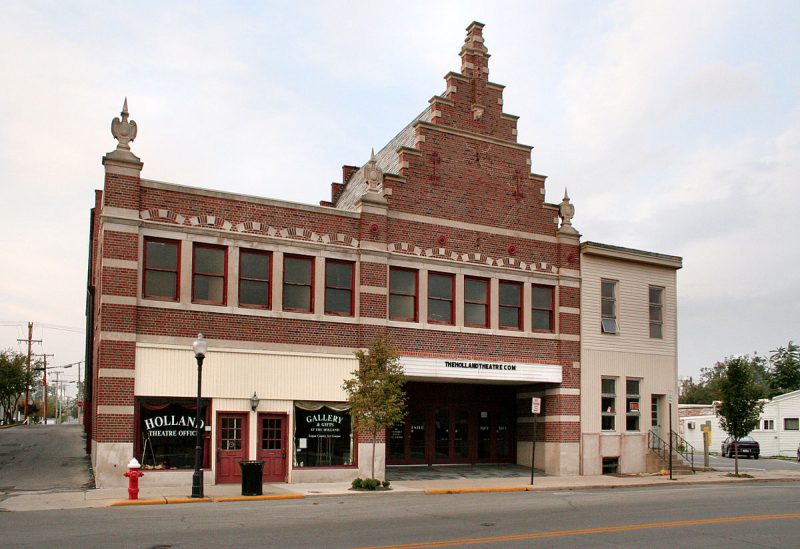
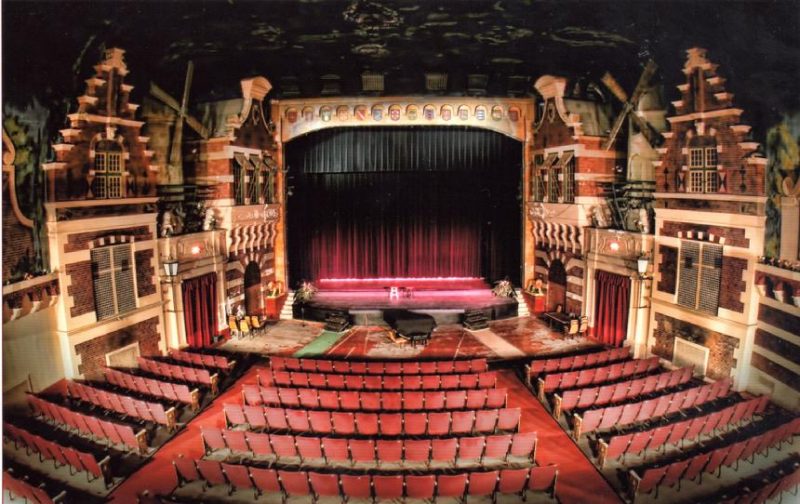
Current Name of Theater: Holland Theatre
Current Type: Atmospheric theatre
Seats: 1,200 / 1 screen
Website: http://thehollandtheatre.org/
Historic Names of Theater: P
Address: 127 E Columbus Ave, Bellefontaine, OH 43311
Contact:
Phone: (937) 592-9002
Email: office@thehollandtheatre.net
Year Built/Style: 1931 / Dutch Atmospheric Theatre
Original Architect: Schine Brothers of the Schine Circuit Theaters, hired the architect Peter M. Hulsken
Original Cost:
Listed on National Register: yes
NRHP Reference # 01000561
Added to NRHP – May 25, 2001
History of Theater:
Cost of Rehabilitation:
Architect: Hoseler Bros.
Contractors:
Source of Funds:
Renovation Story: In 1998 the Holland was closed as a movie house
The Holland Theatre is a unique atmospheric theatres. Designed by Holland-born architect Peter M. Hulsken, the auditorium was inspired by his Dutch birth place. The design was patented (copy righted) and remains a one of a kind design. No other Dutch atmospheric theatre can be found in the United States and possibly the world. The outside of the theatre boasts a stepped gable front and the Dutch cross bond pattern of bricks which would look at home on the streets of Amsterdam. The inside of the auditorium has a ceiling that looked like an evening sky, with twinkling stars and moveable clouds. The walls are adorned with a façade of windmills (whose sails rotate), canal houses with lighted windows, and tulip filled window boxes. Shields from Dutch cities decorate the proscenium arch and the balcony and two majestic lions guard the stage. Nowhere else can a theatre be found in this nation that transforms a small town in Ohio into an old street scene in Holland.
The Holland Theatre, like most old movie houses, fell on hard times with the advancement of technology. The Holland saw many owners, all of which tried to meet the needs of the public, with changes to the theatre. It was multiplexed in an attempt to compete with the newer theatres. Through it all the changes were made with respect to the theatre’s design and the integrity of the design was maintained. In 1998 the Holland was closed as a movie house. It was feared that the Holland would fall to the wrecking ball.
In 1999, with the help of many concerned citizens and a group of gifted local junior high students, the wheels were set in motion to reopen and restore this beautiful structure. The Logan County Landmark Preservation, Inc. was formed and with their hard work and the support of the community, even in this time of financial hardship, the Holland is thriving as a venue for the performing arts and a home for the visual arts. The fact that the Theatre is being restored and is active is a testament to the importance and historical significance of the Holland. It remains a vital cog in the heart of this small rural community. The Holland is a monument to our past and a significant part of our future.
In the early days of moving pictures, American entertainment companies vied for market share by offering their films in opulent theaters. Going to the movies was an event. Men wore their Sunday suits for the occasion; women donned their hats and stockings; and films were shown in movie “palaces”, lush fantasy lands filled with velvet-covered seats and crystal chandeliers. For the price of a forty-cent ticket, moviegoers not only would be transported into the celluloid world, but also could enjoy the type of extravagant surroundings usually reserved for the very wealthy.
American theatre architecture peaked in the 1920’s. Hundreds of elaborate movie palaces were built across the United States in towns both large and small. Often these theatres were constructed in an atmospheric style. They resembled Italian piazzas, Grecian ruins, and Moorish courtyards. As patrons found their seats, Corinthian columns, classical facades, and tastefully draped statues of coy Roman goddesses flanked them. Mosaic tiled fountains sang in the lobbies and coming feature posters were hung in gilded frames. The Italian and Spanish styles were very popular, and many of the remaining theaters were built with those contrivances. However, a single historic atmospheric theatre stands out among the dozens listed on the National Register of Historic Places and on the rolls of the Theatre Historical Society of America — Bellefontaine’s historic Holland Theatre.
Schine Enterprises, a family company that built and operated about 150 theatres in six states, built the Holland Theatre in downtown Bellefontaine, Ohio, in 1931. The Schine’s Holland Theatre in Bellefontaine is the only Dutch-style atmospheric theater in the United States, and perhaps the only one existing in the world. The Holland Theatre not only represents a nostalgic part of Logan County’s past, but it also offers new opportunities for the county’s future.
From the outside, the Holland Theatre has not changed dramatically since it was built. The exterior of the Theatre is attractive rose-colored brick. The three story structure has a stepped, Flemish-style gable that gives only a hint of as to what awaited movie-goers inside when the Theatre was in its heyday. Although the lobby and main foyer of the Holland has been cosmetically altered through the decades, originally both spaces introduced the Dutch theme with its hewn timber framed beams, heavy plastered walls, and reproductions of famous Dutch paintings hung between field-paneled walls.
While 1,400 patrons sat in air-conditioned or heated comfort, they did so as their eyes told them they were outdoors. The interior auditorium was designed as a convincing representation of a 17th-century Dutch cityscape. Blooming tulips waved gently in window boxes as two working windmills quietly stirred the air. The brick and timber-framed facades were careful reproductions, nearly actual sized, of known buildings – one of which was the family home of the Holland’s architect, Peter Hulsken. Windows in these facades were dimly lit from within, giving the impression that building’s interiors were illuminated by candlelight. The ceiling was painted a deep blue, and tiny lights simulated flickering stars. A cloud machine completed the effect. The largest movie screen in Ohio, 40-feet long, filled the stage.
On December 28,1999, The Historic Holland Theatre was purchased for the Logan County Landmark Preservation, Inc. by Richard and Peggy Knowlton.
![]()
Financing Historic Theater Redevelopment Webinar
May 16, 2017 1 pm – 2 pm
Historic theaters are key structures for creating a sense of place and often have a rich history of being a community’s economic driver. For theaters that have fallen into disrepair, changing their fate requires vision, planning, and a commitment to financing. During this installment of the CDFA // BNY Mellon Development Finance Webcast Series, CDFA has partnered with Heritage Ohio to explore the wealth of financing tools available to redevelop historic theaters, including 501(c)(3) bonds, TIF, tax credits, and other creative programs. Join us for this special discussion as we highlight success stories from historic theaters across the U.S.
For this webinar, AIA members can receive 1.0 HSW credits. Please contact Joyce at jbarrett@heritageohio.org to receive your credit and get your certificate of completion.
Register Here
Not a Member? Join Heritage Ohio Now
B Street Theatre, Sacramento, California
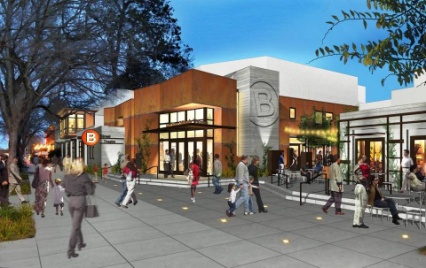 The B Street Theatre is a 501(c)(3) nonprofit theater founded in 1986 by Timothy Busfield. Its mission is to promote education, literacy, social interaction, and cultural enrichment by engaging children and adults in the arts. The theatre is currently undergoing a $29 million renovation that includes bond financing, loans, guarantees, and grants. The new theater complex will include the 365-seat Sutter Children’s Theater and the 250-seat Mainstage Theater. B Street estimates that the new complex will allow them to serve 35,000 more children and families than their current venue.
The B Street Theatre is a 501(c)(3) nonprofit theater founded in 1986 by Timothy Busfield. Its mission is to promote education, literacy, social interaction, and cultural enrichment by engaging children and adults in the arts. The theatre is currently undergoing a $29 million renovation that includes bond financing, loans, guarantees, and grants. The new theater complex will include the 365-seat Sutter Children’s Theater and the 250-seat Mainstage Theater. B Street estimates that the new complex will allow them to serve 35,000 more children and families than their current venue.
RiNo Arts District, Denver, Colorado
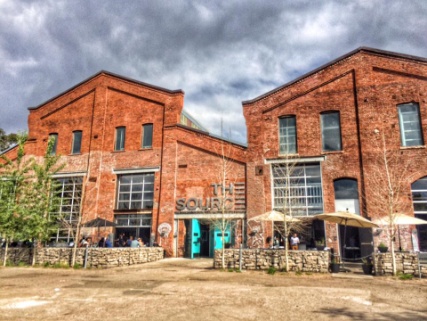 The River North (RiNo) Arts District is located in Denver’s five points neighborhood; a historically industrial part of the city. As industry moved out of the city towards the turn of the century, the neighborhood was plagued with vacant buildings and poor infrastructure. In 2004 local neighborhood leaders started devising a plan to revitalize the area. This plan has been realized through the creation of a Business Improvement District and General Improvement District. The RiNo Arts District is now home to a bustling arts community that includes galleries, architects, and myriad creative businesses.
The River North (RiNo) Arts District is located in Denver’s five points neighborhood; a historically industrial part of the city. As industry moved out of the city towards the turn of the century, the neighborhood was plagued with vacant buildings and poor infrastructure. In 2004 local neighborhood leaders started devising a plan to revitalize the area. This plan has been realized through the creation of a Business Improvement District and General Improvement District. The RiNo Arts District is now home to a bustling arts community that includes galleries, architects, and myriad creative businesses.
Capitol Theatre, Cleveland, Ohio
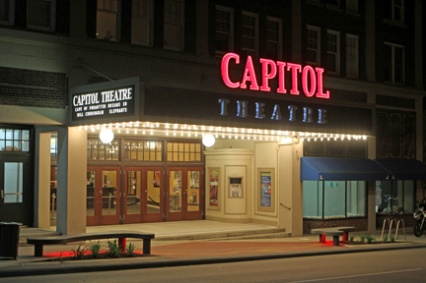 The Capitol Theatre first opened its doors on April 8, 1921 as a silent film house. The theatre remained a centerpiece of the Gordon Square neighborhood, but began to fall into disrepair following the outmigration of people from Cleveland after World War II. The Theatre was nearly torn down in 1978, but for the work of Detroit Shoreway Development Corporation to save it. The theatre was eventually closed in 1985 due to its poor condition. However, Detroit Shoreway continued to work to save this theatre and through the use loans, grants, historic tax credits, and New Markets Tax Credits, were able to reopen the fully renovated theatre in 2009. The three-stage, 602 seat theatre is now used as a cinema.
The Capitol Theatre first opened its doors on April 8, 1921 as a silent film house. The theatre remained a centerpiece of the Gordon Square neighborhood, but began to fall into disrepair following the outmigration of people from Cleveland after World War II. The Theatre was nearly torn down in 1978, but for the work of Detroit Shoreway Development Corporation to save it. The theatre was eventually closed in 1985 due to its poor condition. However, Detroit Shoreway continued to work to save this theatre and through the use loans, grants, historic tax credits, and New Markets Tax Credits, were able to reopen the fully renovated theatre in 2009. The three-stage, 602 seat theatre is now used as a cinema.
Next Stage Arts, Putney, Vermont
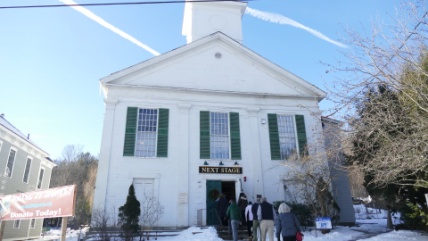 Next Stage is located inside 15 Kimball Hall, a beautiful, historic church built in 1841 in the heart of Putney, Vermont. The theater re-opened in 2016 as a fully accessible venue with an elevator and hearing assist technology. Other upgrades include air-conditioning and brand new seating. The 180 seat venue attracted hundreds of thousands of dollars of investment in the way of grants in order to support its renovation. The theater now holds events such as spoken word, independent film showings, and concerts.
Next Stage is located inside 15 Kimball Hall, a beautiful, historic church built in 1841 in the heart of Putney, Vermont. The theater re-opened in 2016 as a fully accessible venue with an elevator and hearing assist technology. Other upgrades include air-conditioning and brand new seating. The 180 seat venue attracted hundreds of thousands of dollars of investment in the way of grants in order to support its renovation. The theater now holds events such as spoken word, independent film showings, and concerts.
Our Presenters
 Nancee Trombley is the Chief Deputy Executive Director for the California Infrastructure and Economic Development Bank (iBank) a division of the Governor’s Office of Business and Economic Development. She oversees IBank’s Infrastructure State Revolving Fund, the Bond Unit, and the Small Business Finance Center. Nancee earner a BS in Communications from California State University at Sacramento and an Executive MBA from California State University at Monterey Bay.
Nancee Trombley is the Chief Deputy Executive Director for the California Infrastructure and Economic Development Bank (iBank) a division of the Governor’s Office of Business and Economic Development. She oversees IBank’s Infrastructure State Revolving Fund, the Bond Unit, and the Small Business Finance Center. Nancee earner a BS in Communications from California State University at Sacramento and an Executive MBA from California State University at Monterey Bay.
 Tracy Weil, Co-Founder and Creative Director of the RiNo Art District, specializes in building community. The RiNo Art District is booming as Denver’s new creative community. Weil has been a driving force in the development of this creative district. Weil is also an visual artist painting for over 25 years, Weil continues to pursue his consulting practice as an advocate for artists and creating vibrant art focused communities.
Tracy Weil, Co-Founder and Creative Director of the RiNo Art District, specializes in building community. The RiNo Art District is booming as Denver’s new creative community. Weil has been a driving force in the development of this creative district. Weil is also an visual artist painting for over 25 years, Weil continues to pursue his consulting practice as an advocate for artists and creating vibrant art focused communities.
 Jeff Ramsey, is executive director of the Detroit Shoreway Community Development Organization. DSCDO has preserved 14 historic buildings and created nearly 300 units of affordable housing, many of which are located in the heart of Gordon Square, home to the Capitol Theater.
Jeff Ramsey, is executive director of the Detroit Shoreway Community Development Organization. DSCDO has preserved 14 historic buildings and created nearly 300 units of affordable housing, many of which are located in the heart of Gordon Square, home to the Capitol Theater.
 Billy Straus is an American music producer and songwriter. He is known for his work in children’s television including the Disney series Little Einsteins and Where in the World Is Carmen Sandiego?. He produced and mixed original Broadway cast albums for The Full Monty and Dirty Rotten Scoundrels. He won an Emmy Award for his work on Where in the World Is Carmen Sandiego? He founded Rock River Communications to introduce the concept of non-traditional music distribution into the retail marketplace.
Billy Straus is an American music producer and songwriter. He is known for his work in children’s television including the Disney series Little Einsteins and Where in the World Is Carmen Sandiego?. He produced and mixed original Broadway cast albums for The Full Monty and Dirty Rotten Scoundrels. He won an Emmy Award for his work on Where in the World Is Carmen Sandiego? He founded Rock River Communications to introduce the concept of non-traditional music distribution into the retail marketplace.
![]()



